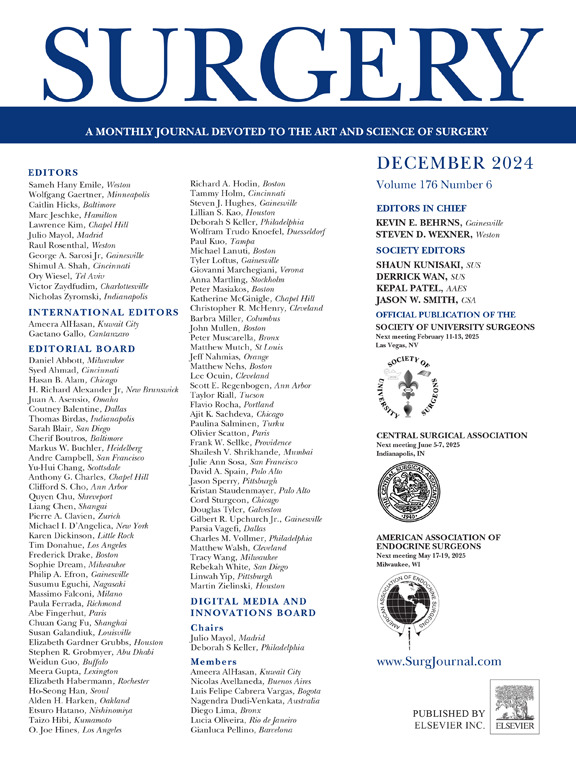Assessing the pathway and timing for ileostomy reversal in rectal cancer: A retrospective cohort study
IF 3.2
2区 医学
Q1 SURGERY
引用次数: 0
Abstract
Background
Surgery for locally advanced rectal cancer often requires temporary fecal diversion, which significantly impacts quality of life and can lead to unintended morbidity. Patients typically are counseled that reversal is planned for 3 months postoperatively, but the actual time to reversal and factors that may delay closure are poorly understood. We aimed to evaluate time from diversion to ostomy reversal, with secondary outcomes including patient- and systems-level factors influencing this timeline.
Methods
This retrospective cohort study included patients with stage I-III rectal cancer who underwent low anterior resection with diverting loop ileostomy between 2011 and 2022 at a tertiary center. Median time to reversal and intervals to prereversal events were determined. A stepwise Cox proportional hazards model was used to identify factors associated with prolonged time to reversal, whereas Kaplan-Meier methods were applied to estimate median time to reversal for subgroups.
Results
Among 133 patients, 79.0% (n = 105) had their stomas reversed after a median of 5.5 months. Delays were observed in time to follow-up appointments, endoscopic evaluations, and gastrografin enemas. Prolonged time to closure was associated with receipt of adjuvant therapy (hazard ratio, 0.50; 95% confidence interval, 0.29–0.85), ASA status ≥3 (hazard ratio, 0.59; 95% confidence interval, 0.39–0.90), Clavien-Dindo complications ≥3 (hazard ratio, 0.32; 95% confidence interval, 0.11–0.91), persistent anastomotic disruption (hazard ratio, 0.36; 95% confidence interval, 0.15–0.85), and more follow-up appointment cancellations (hazard ratio, 0.35; 95% confidence interval, 0.18–0.68).
Conclusion
Stoma reversal often exceeds the anticipated 3-month timeline as the result of patient risk factors and anastomotic evaluation protocols. Identifying these barriers is essential to develop standardized, timely, and patient-centered reversal metrics.
评估直肠癌回肠造口逆转的途径和时机:一项回顾性队列研究
背景局部晚期直肠癌的手术通常需要暂时的粪便转移,这严重影响了患者的生活质量,并可能导致意外的发病率。患者通常被告知术后3个月计划进行逆转,但对逆转的实际时间和可能延迟关闭的因素知之甚少。我们的目的是评估从转移到造口逆转的时间,次要结果包括患者和系统层面的因素影响这一时间。方法:本回顾性队列研究纳入2011年至2022年在三级中心接受低位前切除术合并回肠袢转移造口术的I-III期直肠癌患者。确定到逆转的中位时间和到逆转事件的间隔。逐步Cox比例风险模型用于确定与逆转时间延长相关的因素,而Kaplan-Meier方法用于估计亚组的中位逆转时间。结果133例患者中,79.0% (n = 105)的造口在中位5.5个月后逆转。观察到随访预约、内窥镜评估和胃grafin灌肠的时间延迟。闭合时间延长与接受辅助治疗有关(风险比,0.50;95%可信区间0.29-0.85),ASA状态≥3(风险比0.59;95%可信区间,0.39-0.90),Clavien-Dindo并发症≥3(风险比,0.32;95%可信区间,0.11-0.91),持续性吻合口破裂(风险比,0.36;95%可信区间,0.15-0.85),更多的随访预约取消(风险比,0.35;95%置信区间,0.18-0.68)。结论由于患者的危险因素和吻合方式的影响,吻合逆转往往超过预期的3个月时间。识别这些障碍对于制定标准化、及时和以患者为中心的逆转指标至关重要。
本文章由计算机程序翻译,如有差异,请以英文原文为准。
求助全文
约1分钟内获得全文
求助全文
来源期刊

Surgery
医学-外科
CiteScore
5.40
自引率
5.30%
发文量
687
审稿时长
64 days
期刊介绍:
For 66 years, Surgery has published practical, authoritative information about procedures, clinical advances, and major trends shaping general surgery. Each issue features original scientific contributions and clinical reports. Peer-reviewed articles cover topics in oncology, trauma, gastrointestinal, vascular, and transplantation surgery. The journal also publishes papers from the meetings of its sponsoring societies, the Society of University Surgeons, the Central Surgical Association, and the American Association of Endocrine Surgeons.
 求助内容:
求助内容: 应助结果提醒方式:
应助结果提醒方式:


